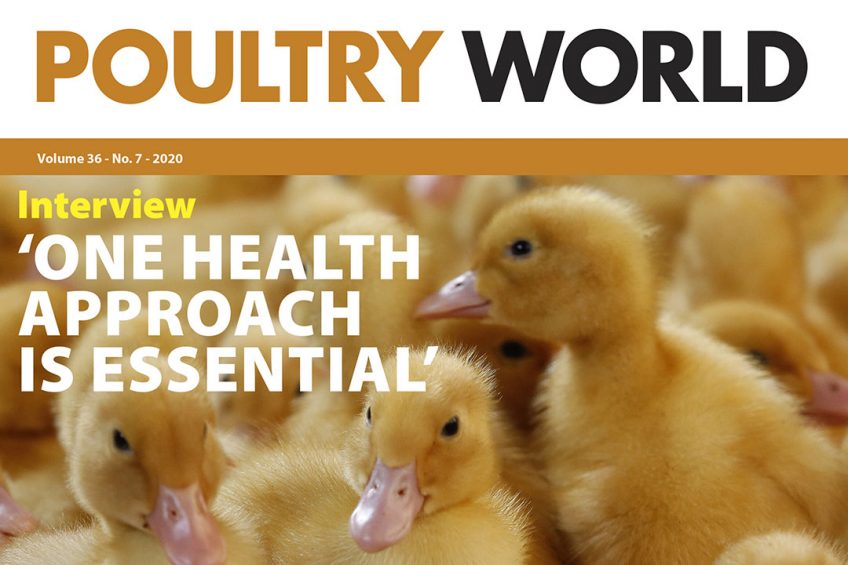Poultry World edition 7 of 2020 is now online

In this edition of Poultry World we interview Rens van Dobbenburgh, president of the Federation of Veterinarians of Europe, to talk about how one health approach is essential. We visit a farm in South Africa where demand is strong for the indigenous Boschveld breed of chickens, and we discuss how to ensure healthy and profitable production for Pekin ducks. Poultry World also considers the value of LED lighting in breeder production and algae residuals as chicken feed.
View Poultry World’s digital magazine
“One Health approach is essential”
In this article, we speak to Rens van Dobbenburgh, president of the Federation of Veterinarians of Europe, which represents about 300,000 veterinarians in 40 member countries. We discuss veterinary medicines, their availability and proper use, animal health in general, animal welfare, and food safety.
Popularity of poultry continues globally
In 2019, the global poultry market increased by 6% to US$231.5 billion, rising for the third consecutive year. Global consumption peaked and is expected to continue to climb.
Strong demand for mixed day-old chicks in South Africa
The lockdown in South Africa brought the country to a halt, but chicken farmer Mike Bosch saw an increase in demand for mixed day-old chicks. Since having bred his own indigenous free-range bird, a 3-way cross called the Boschveld over 20 years ago, Mike has enjoyed huge success in exporting his chickens throughout Africa.

Lack of commercialisation of technologies hindering layer productivity improvements
Several technologies can improve layer productivity, but they are hampered by a lack of commercial systems and evidence of their practical benefits. Dr Cutress at the University of Aberystwyth’s Institute of Biological, Environmental and Rural Sciences PreciseAg Project, says that one of the issues for the egg sector is that precision tools, while often affordable, have difficulty in transitioning from prototypes to commercial systems.

Using LED lighting in breeder production
Over the years, LED light has proven to work as well as traditional light sources in bringing parent stock into production. One major advantage, however, is that LED means much lower energy costs.

Algae residuals as chicken feed?
Belgian researchers are investigating how residual flows from algae production for human consumption can deliver value to chicken feed.

Core metagenomic functions of the poultry microbiome
Microbial profiles tell us the types and amounts of the various micro-organisms present in the gut; however, gut composition varies from bird to bird. Looking at the metagenome makes it decidedly simpler.
View Poultry World’s digital magazine
Preparing for a new flock of Pekin ducks
The first 3 days of a duck’s life determine the rest of its existence. Pekin ducks are fast-growing and must be supported as they arrive at the farm. In this article, we unpack 7 essential points to take into account when preparing for a new flock.

Synergistic feed additive: A strategy to reduce antimicrobials
Gut health is a key factor in supporting immunity, though it is an enduring challenge for broiler
producers, accounting for up to 80% of antimicrobials used in poultry production. A synergistic approach leverages different feed additives as part of a 4-pronged gut health strategy to support broiler health while reducing or removing antibiotics.
Insight into avian virus highlights its infection potential
Commercial poultry should be protected from the risk of contracting harmful bird flu from migrating flocks. Viruses can readily exchange genetic material with other viruses during migration, raising the likelihood of serious outbreaks in domestic poultry and wild birds.

Need for natural alternatives to AGPs
Necrotic enteritis (NE) in broilers is just one of the diseases held at bay by in-feed antibiotic growth promoters (AGPs). With the ban on AGPs looming, a need for natural alternatives arises. Wood lignans in the polyphenol category are offering interesting properties for controlling NE.
To access the magazine section, where you will find the 7th edition of Poultry World 2020 as well as other magazines from specialists in the agriculture industry, simply register for free.













